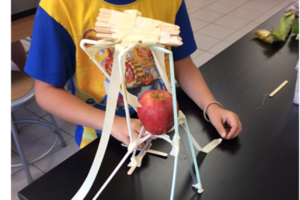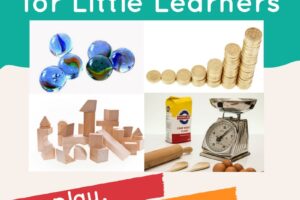I am often asked how to get started with STEM in the regular education classroom, and even more often, what supplies are necessary. As a former classroom teacher, I remember well that the ONE thing I dreaded about teaching science was the prep time. Lengthy lists of materials, complicated setup, and an extra trip to Walmart were sometimes enough to make me throw in towel because the truth is, ain’t nobody got time for that! My experience with STEM, especially with my Kindergartners, first graders, and second graders, has taught me that the more simple the list of materials, the better. There are COUNTLESS existing materials in most classrooms that lend themselves beautifully to challenges. I’ve also figured out ways to use a variety of math manipulatives within challenges because, let’s face it, young students absolutely LOVE to build with manipulatives anyway!
Here’s a list of 10 STEM supplies and construction materials that you (probably) already have in your classroom. And if you don’t, I guarantee there’s an early childhood teacher who does and would be kind enough to share!
If you are an early childhood teacher, you know that base ten blocks ALWAYS require a short exploration time prior to using them for a math lesson because the kids Just. Can’t. Handle not building towers and structures. Why not incorporate them into a STEM challenge? Perfect for shelters, bridges, and more!
Linking/unifix cubes are a common go-to for my classroom STEM challenges because they are quick and easy for students to shorten and lengthen structures. They are sturdy to withhold a decent amount of weight, and they work beautifully for adjusting heights of ramps. We also use individual unifix cubes to test the durability of bridges, boats, and other structures.
Dominoes are fun balancing challenge for certain types of structures if students choose to stand them on their ends. They also work perfectly for mazes!
Students can mold just about anything with play dough or clay. If you don’t have some on hand in your classroom, many Kindergarten and first grade teachers in your building likely do. Not only can you mold structures using play dough alone, it is perfect to use in combination with popsicle sticks, toothpicks, or skewers to build more elaborate structures.
You can do A LOT with paper during a STEM challenge, and cards are no different! Many times, all that students need is some Scotch tape for their creations to take shape.
Don’t throw away those leftover paper goods from classroom holiday parties and birthday parties! We use paper goods ALL THE TIME during STEM challenges! Dixie cups work perfectly for parachute baskets, and plates and bowls are often used for boat construction. Plastic cups are great for towers and bridges, and spoons make excellent additions to catapults!
We have used popsicle sticks for three different challenges so far this year: pumpkin catapults, Thanksgiving dinner tables, and a shelf for the elf. You could say it’s one of my favorite STEM materials because it’s so versatile and inexpensive! I picked up a box of 1,000 today for $5.00!
Anything malleable, yet sturdy is an ideal STEM tool, and pipe cleaners fit the bill. They are great for connecting pieces of structures together or building bridges. They also work well as a substitute for yarn or string (especially for the littles) when tying ends is too complicated.
 You use them for math. You use them for science. Why not use them for STEM?! Oftentimes, the engineering and science pieces of STEM are easy to spot, but the math is more difficult to pull out. Incorporating a measurement piece is the perfect way to tie in math in a way that is relevant and meaningful.
You use them for math. You use them for science. Why not use them for STEM?! Oftentimes, the engineering and science pieces of STEM are easy to spot, but the math is more difficult to pull out. Incorporating a measurement piece is the perfect way to tie in math in a way that is relevant and meaningful.

Rubber bands are great for catapults, slingshots, and trampolines. They might be hiding at the bottom of your desk drawer, but they’re perfect for a STEM challenge! If you have geoboards in your classroom, you also likely have a stash of rubber bands for those too.
I hope these suggestions for STEM supplies might help you to breathe a sigh of relief before jumping headfirst into STEM! Working smarter (not harder) means using the materials that you have at your disposal. Take a look in your classroom and consider the possibilities for engineering. They are all around you!
***Clip art by 2 Super Teachers, Digital papers and elements by I Teach, What’s Your Superpower?, and fonts by KG fonts***













Leave a Reply
Your email is safe with us.